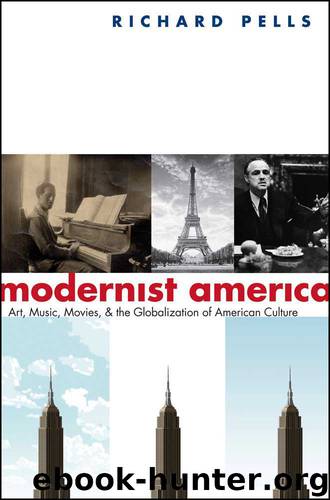Modernist America by Richard Pells

Author:Richard Pells
Language: eng
Format: epub
Publisher: Yale University Press
Published: 2011-09-22T04:00:00+00:00
The Ascendancy of Film Noir
As a way of boosting movie attendance in America during the depths of the Depression, theater owners and the Hollywood studios began showing two films for the price of a single ticket—a practice called the “double feature” that lasted until the early 1950s. But a reliance on double features meant that Hollywood would have to turn out more films.
In order to meet the increased demand for movies without straining their annual budgets, the studios started making what came to be known as B pictures. These were less expensive movies, often without major stars or lavish costumes and sets, and also without the supervision that the studios imposed on their costlier and more highly publicized films. Thus the directors of B movies could frequently experiment with new techniques and less conventional themes of the sort that a producer on an A film might have forbidden.
B movies, with their stripped-down plots and truncated shooting schedules, where the dimly lit ambience of a movie mattered more than its actors or their dialogue, were a perfect medium for film noir.24 And for émigré directors too little known or eccentric to be entrusted with big-budget movies. Indeed, without the phenomenon of the B movie, film noir might have never emerged in the United States.
The first examples both of B pictures and film noir were horror movies, one of the most popular genres of the 1930s. Universal was the principal studio specializing in tales of fear, often under the guidance of Tod Browning or James Whale, a British stage director who had come to Hollywood at the beginning of the 1930s. Browning and Whale directed some of the classic horror films of the decade: Dracula, The Invisible Man, Frankenstein, and The Bride of Frankenstein.
Most of these movies—usually starring Béla Lugosi or Boris Karloff (who, like Whale, was from Britain)—were reinterpretations of stories that had their origins either in European literature or in German Expressionist films. Browning’s Dracula in 1931 was essentially a remake of F. W. Murnau’s Nosferatu. Whale’s two Frankenstein films were based on Mary Shelley’s British novel, itself an exploration of Gothic terror fashionable in nineteenth-century European fiction. The horror movies were therefore full of ominous lighting and treacherous shadows, lifeless forests and fog-bound swamps, crumbling castles and petrified townspeople, demented scientists and alien monsters. The pervasive atmosphere of violence, terror, and death was an inheritance both from the more frightening novels of the previous century and from the Expressionist canon of the 1920s.
An additional Expressionist ingredient in these films was their fascination with megalomania. The true villains of the horror movies were not the monsters but those who wished to tamper with the natural order of the universe. The personification of evil was generally an isolated, half-crazed scientist who dedicated his career to the unfettered pursuit of knowledge regardless of its consequences. The effort, as in the case of the Frankenstein films, to defy death and create an ideal human specimen was also a quest for unlimited power over the world.
Download
This site does not store any files on its server. We only index and link to content provided by other sites. Please contact the content providers to delete copyright contents if any and email us, we'll remove relevant links or contents immediately.
4 3 2 1: A Novel by Paul Auster(12289)
The handmaid's tale by Margaret Atwood(7681)
Giovanni's Room by James Baldwin(7197)
Asking the Right Questions: A Guide to Critical Thinking by M. Neil Browne & Stuart M. Keeley(5649)
Big Magic: Creative Living Beyond Fear by Elizabeth Gilbert(5615)
Ego Is the Enemy by Ryan Holiday(5297)
The Body: A Guide for Occupants by Bill Bryson(4976)
On Writing A Memoir of the Craft by Stephen King(4863)
Ken Follett - World without end by Ken Follett(4646)
Adulting by Kelly Williams Brown(4488)
Bluets by Maggie Nelson(4476)
Eat That Frog! by Brian Tracy(4436)
Guilty Pleasures by Laurell K Hamilton(4362)
The Poetry of Pablo Neruda by Pablo Neruda(4041)
Alive: The Story of the Andes Survivors by Piers Paul Read(3970)
White Noise - A Novel by Don DeLillo(3955)
Fingerprints of the Gods by Graham Hancock(3943)
The Book of Joy by Dalai Lama(3903)
The Bookshop by Penelope Fitzgerald(3779)
